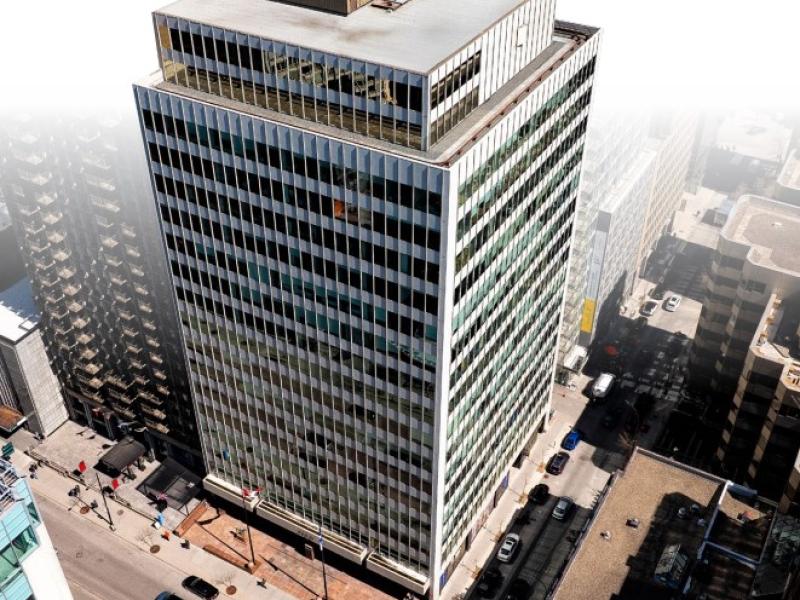 The Canadian commercial real estate total return rate bounced back to 7.9 per cent in 2021 after plummeting to negative 4.1 per cent a year earlier due to the pandemic, according to the latest MSCI/REALPAC Canada Property Index.
The Canadian commercial real estate total return rate bounced back to 7.9 per cent in 2021 after plummeting to negative 4.1 per cent a year earlier due to the pandemic, according to the latest MSCI/REALPAC Canada Property Index.
Much of that improvement can be attributed to the industrial asset class, which had a record-breaking 31.6 per cent total return.
“We did see some improving performance throughout the year,” MSCI executive director Simon Fairchild said during the virtual MSCI/REALPAC Canada Real Estate Investment Forum, which was hosted by REALPAC chief executive officer Michael Brooks on Jan. 31.
“Q4 turned out to be the strongest of the four quarters. It’s an encouraging picture in terms of the levels we got to for the calendar year and also a progression towards recovery.”
The overall total income return was 4.3 per cent and capital growth was 3.6 per cent, well above the long-run average of just under two per cent per year.
There was five per cent growth in net operating income (NOI) across industrial, residential, office and retail asset classes.
“There’s improvement in the fundamentals of real estate in Canada, but it’s not everywhere and it’s not in everything,” said Fairchild.
Fengate managing director and group head of real estate Jaime McKenna, BentallGreenOak managing partner and head of Canada Paul Mouchakkaa, and Healthcare of Ontario Pension Plan (HOOPP) head of global real estate Eric Plesman provided perspectives as part of the online forum.
All utilize the MSCI/REALPAC Property Index for benchmarking purposes.
What the MSCI/REALPAC Property Index measures
The index measures unlevered total returns of directly held property investments. Its goal is to enhance transparency, enable comparisons of real estate relative to other asset classes and facilitate comparisons of Canadian real estate performance to other private real estate markets globally.
The index started in 1985. It includes buying, selling, development and redevelopment activity data provided by major pension funds, insurance companies and large real estate owners in Canada.
The 2021 index encompassed 46 portfolios with 2,367 assets totalling 483.7 million square feet and a gross capital value of $171.6 billion. Fairchild estimates the index represents about 40 per cent of the professionally managed commercial real estate market in Canada.
The index has averaged an annual total return of 9.8 per cent since inception and 6.9 per cent over the past 10 years. Last year was the best performance since 2015, when the total return was eight per cent.
Three other countries have thus far released 2021 figures. The United Kingdom leads the way with a 20 per cent total return, followed by the U.S. at 18.2 per cent and Ireland at 4.3 per cent.
Industrial is the dominant asset class
One of the reasons the industrial sector performance was so strong, with its 26.4 per cent capital growth and 4.2 per cent income return, was that rents rose by 8.2 per cent last year and are expected to keep increasing this year and beyond.
There was also 8.2 per cent growth in NOI for industrial properties and investment in the sector rose from $1.29 billion to $2.41 billion year-over-year.
Industrial was particularly strong in Toronto, which had a nearly 40 per cent increase in industrial capital values and a 10 per cent increase in NOI.
Jim Costello, MSCI’s head of real estate economics, said there was 22 per cent growth in Canadian industrial prices in 2021 and the value of annual industrial construction reached a record high of more than $10 billion.
Despite all of that development, supply still isn’t keeping up with demand.
Costello said Statistics Canada began measuring e-commerce activity in 2016 and it’s grown from a two per cent share of all retail sales to seven per cent last year.
“For every dollar spent on consumption activity, it generates three times as much demand for industrial space by companies that shift these goods around,” he said.
The industrial sector has an availability rate of around two per cent across Canada, with plenty of old inventory. Mouchakkaa believes there’s still room to grow because of all the demand.
In addition to the rise in e-commerce, McKenna said the industrial sector is also being fuelled by the need for supply chain independence, which has grown during the pandemic.
Fengate likes industrial buildings with 200,000- to 300,000-square-foot footprints and prefers developing over bidding wars to acquire existing properties.
HOOPP remains bullish on industrial. Where companies have a development pipeline that enables it to replenish inventory and add to its weighting, Plesman expects some may sell certain properties to take advantage of high industrial pricing.
Residential sector has second-highest return
The residential asset class had a seven per cent total return last year, 3.8 per cent of it attributable to capital growth, and was the second-best performer. Net investment in the sector was $703.5 million. While that’s solid, residential saw its NOI drop by 5.8 per cent.
“Investors have a positive view of residential and have almost discounted the current falls in NOI,” said Fairchild. “Residential values were up, perhaps representing a stronger outlook for that sector.”

Jaime McKenna, managing director and group head of real estate for Fengate Asset Management. (Courtesy Fengate)
McKenna said residential rents were still declining or remaining steady in early 2021, but she started seeing vacancies decrease and rents grow in the second half of the year, particularly in Q4.
Demand continues to far outpace supply for all types of residential properties and McKenna expects the asset class to perform well this year as 400,000 immigrants are expected to enter Canada. Approximately 70 per cent of immigrants rent housing upon their arrival in the country.
An aging population will make retirement homes sought-after.
An expected increase in the number of international students, as more post-secondary institutions return to normal operation and travel restrictions ease after the pandemic’s impact lessens, should also give a boost to the student housing sector.
Office performance was sluggish
The office asset class had a 2.8 per cent total return in 2021. There was negative 1.8 per cent capital growth and a 4.7 per cent income return. Net investment was negative $659.7 million.
There was a 1.1 per cent drop in NOI, which has remained relatively stable through the pandemic due to long leases and secure cash flow from strong tenants.
“It’s a little bit of an improvement on 2020, but probably sluggish at best, to be honest,” said Fairchild.
Suburban office properties were more resilient than those downtown through the early phases of the pandemic, which goes against the grain of typical historical performance. Fairchild pointed out, however, vacancies were creeping up in both segments with rents and NOI weakening.
“There’s certainly been more activity, but until people are all back in their offices I think it’s going to be challenging,” said Plesman.
Mouchakkaa said office investment decisions will be made on a micro basis at the asset level over the next three to five years and not be driven by broader sentiments concerning specific markets.
Retail is still in recovery mode
The retail asset class had a 2.8 per cent total return last year, a strong rebound from 2020 and indicating a partial recovery. There was negative 1.5 per cent capital growth and a 4.3 per cent income return. Net investment was negative $934.7 million.
While the performance of large super-regional malls is still lagging, returns are recovering and values are stabilizing — though still falling on average, according to Fairchild. Enclosed malls, which were effectively shut during COVID-19 lockdowns, experienced some significant write-downs in value.
“More suburban, outdoor and necessity-driven retail has held up much better and that’s still persisting through this recovery phase,” said Fairchild. “The tier-two malls and regional malls have continued to lag, with a negative 0.6 per cent return in 2021.
“Values for those malls are down in aggregate for basically five straight years now. The values were down seven per cent in 2021 and cumulatively down by about 35 per cent.”
There was a 17.4 per cent improvement in retail property NOI last year, but it was down 30 per cent the previous year so that growth still didn’t get the sector back to par.
Accordingly, a 17 per cent recovery in retail rents didn’t translate to growth in capital values because it was just recovering lost ground.
Geographic breakdown
The Canada Property Index looked at the performance of eight major cities.
Toronto finished on top with a 10.8 per cent total return, closely followed by Vancouver at 10.4. Montreal was at 8.2, Halifax at 6.9, Winnipeg at 3.4 and Ottawa at 3.3 per cent.
In Alberta, Edmonton had a three per cent total return while Calgary checked in at negative 1.2 per cent.
“Values in Alberta from our data are down 36 per cent since 2014 in aggregate across all asset types,” said Fairchild. “Offices in downtown Calgary are down 60 per cent.”
“Alberta has continued to take it on the chin since the oil plunge,” said Mouchakkaa. “The only real green chutes that we see in that geography is in the multifamily sector.
“The office sector seems to continue to be declining in that area. That seems to be an area of opportunity, maybe, going forward. But it definitely seems to be a challenge from these numbers.”
NOI growth was 8.1 per cent in Halifax, 7.2 in Montreal and Edmonton, 4.1 in Toronto, 3.4 in Vancouver, 3.3 in Calgary, 1.9 in Ottawa, and 0.8 in Winnipeg.
There was $2.98 billion in net investment. Of that, $2.87 billion was in Toronto, $309.6 million in Vancouver, $104.3 million in Winnipeg and $61.7 million in Calgary. There were net divestitures in the four other markets: $60.2 million in Halifax; $137.3 million in Edmonton; $157.1 million in Montreal; and $385.7 million in Ottawa.
Property Fund Index
In addition to the Canada Property Index, MSCI also has a Property Fund Index focused on open-ended core real estate funds. Nine funds qualified and they’ve grown significantly over the past decade and through 2021. Gross asset values increased from $40 billion in 2020 to $46.8 billion in 2021.
The funds’ underlying real estate assets had an 11.4 per cent total return last year, the highest since June 2013.
Brooks said the gap between the main index’s 7.9 per cent and the Property Fund Index’s 11.4 per cent is the biggest it has ever been.
Fairchild said the Property Fund Index had a higher return than the Canada Property Index because its funds carry 10 per cent more industrial assets.
MSCI and REALPAC
MSCI’s research-based indexes and analytics have helped investors build and manage portfolios for more than 50 years.
Its products and services include indexes, analytical models, data, real estate benchmarks and environmental, social and corporate governance research.
REALPAC, founded in 1970, is the national industry association dedicated to advancing the long-term vitality of Canada’s real property sector.
Its members include publicly traded real estate companies, REITs, private companies, pension funds, banks and life insurance companies with investment real estate.
REALPAC members represent more than $1 trillion of office, industrial, retail, apartment, hotel and seniors residence assets under management across Canada.











